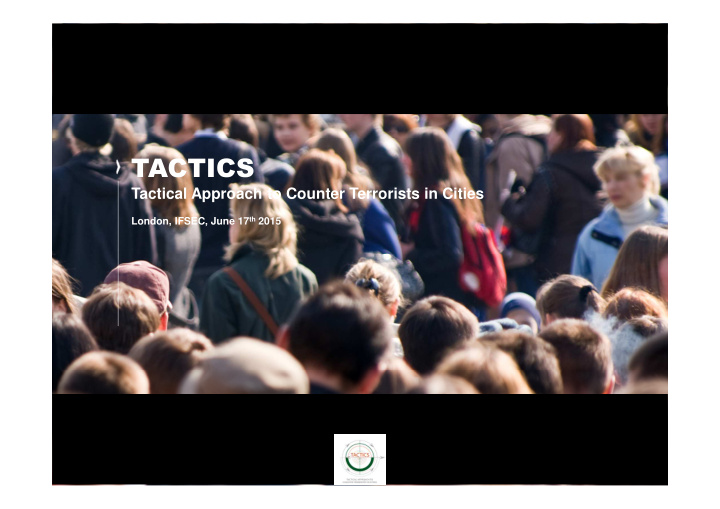



TACTICS Tactical Approach to Counter Terrorists in Cities London, IFSEC, June 17 th 2015
Changing world � Population growth to 8 billion people in 2025 � Climate change � Lack of natural resources � Urbanisation � Changing power relations � New industries and production techniques 2
Our cities change � Changing composition of population: ageing, migration, rising education level � New ways of organising: retreating government, changing participation, open innovation � From growth to transformation: economic crisis, changing needs and supply of natural resources, new types of infrastructure 3
Boundless risk � Infrastructure becomes global � Cascading effects do not stop at country borders � Knowledge about vulnerabilities spreads globally instantaneously � Security requires cooperation between a number of governance levels � Threats are no longer bound to country borders: � Epidemics � Organised crime � Migration � Financial crisis � Climate � Cyber crime � Terrorism 4
New approach to deal with terrorist threat � improving the preparedness of security forces, � the capabilities at their disposal, � and facilitating the emergence of a cross-European common approach. (European Commission, FP7 Security Call, 2011 5
Cross European common approach There are several reasons for a common approach across Europe: � to create support on all relevant policy levels for up to date counter terrorism tactics; � to share information on potential attack vectors (design basis threat); � to develop, validate and share good practices; � to create a sizeable market for the research & development of relevant products and services against new threats, to protect new targets and to address new vulnerabilities; 6
TACTICS vision: a safe city is a smart city Participative risk management in proper harmony with all relevant partners: � Exchanging information about threats, vulnerabilities and good practices � Starting from own strengths Evidence based policies: � Pro effective security measures � Privacy-by-design Robust, timely and proportional deployment of resources for prevention, stopping and recovery 7
The TACTICS approach � Re-use existing security measures � Investigate the use of new security capabilities like: � face recognition in open outdoor situations, � intelligent behaviour camera’s, and � predictive profiling � Apply relevant design principles: � privacy by design; � user centred design; � evidence based policies (TACTICS consortium, 2011) 8
TACTICS Outcome Understanding threat Organizing resources Resources Mitigating threat Time Understanding threat Organizing resources Better Prepared Resources Mitigating threat Time 9
EU FP7 TACTICS 10
Temporal decomposition (and scope of TACTICS) (Failed) attacks Perceived TACTICS deployment threat level Time 11
TACTICS Highlights 12
Questions raised and answered In what kind of context can TACTICS function? � Good basic infrastructure, including ICT for police How to manage a transition in an overconnected society? � Pull one string, see what moves … How do we guard the human factor? � Human intelligence � Street smart / street level bureaucrats � Privacy � Cognitive biases 13
TACTICS is the least invasive approach � Clear scope and goals; � Transparency where possible; � No duplicates of existing data collection resources; � Additional security measures only when needed, and no longer; � Focus on deviant behaviour means that normal behaviour can continue; � Privacy by Design 14
Consortium TNO (Research) RAND Europe (Research) KLPD (Dutch police) PRIO (Peace institute) ITTI (SME) Lero@TCD (University) ISCA (SME) UPV (University) Fraunhofer (Research) KMar (Ministry of Defense) MPH (company) 15
Contact info@fp7-tactics.eu http://www.fp7-tactics.eu/ 16
THANK YOU FOR YOUR ATTENTION QUESTIONS?
Recommend
More recommend